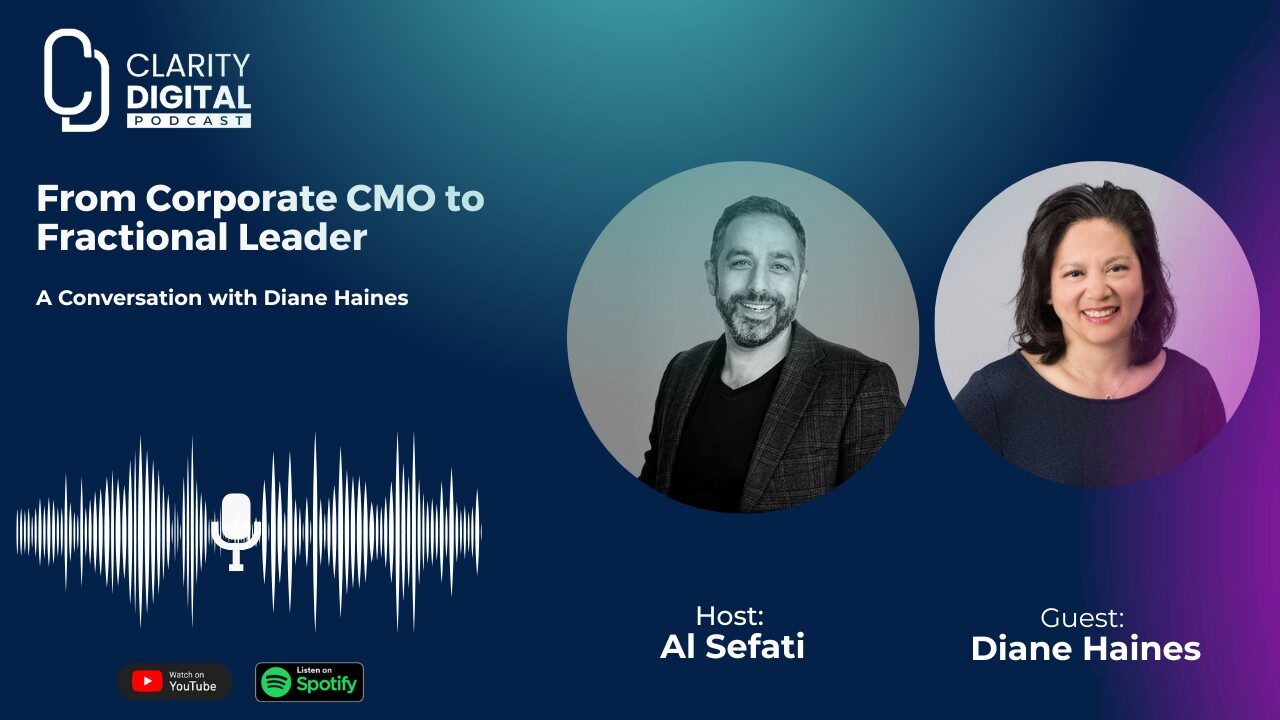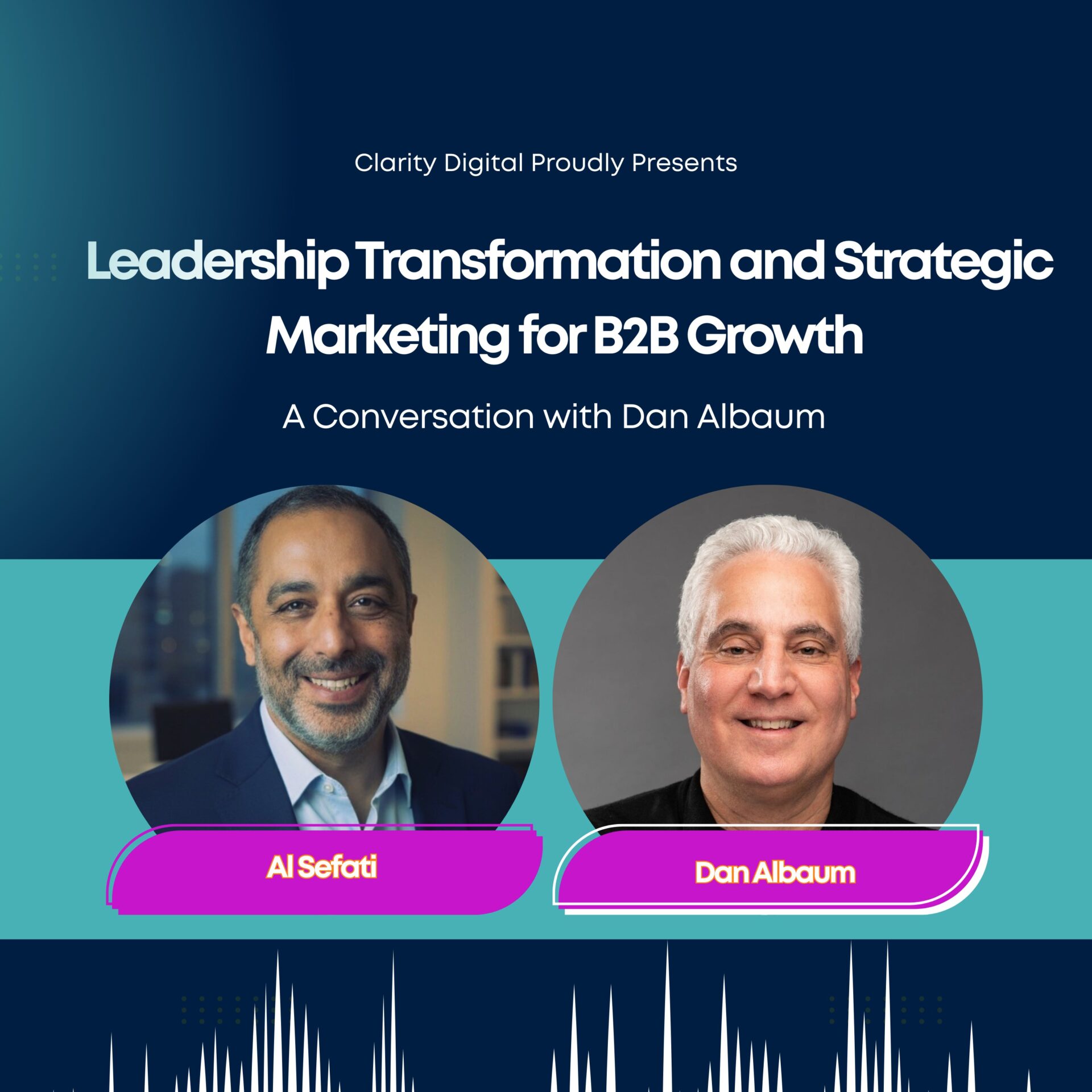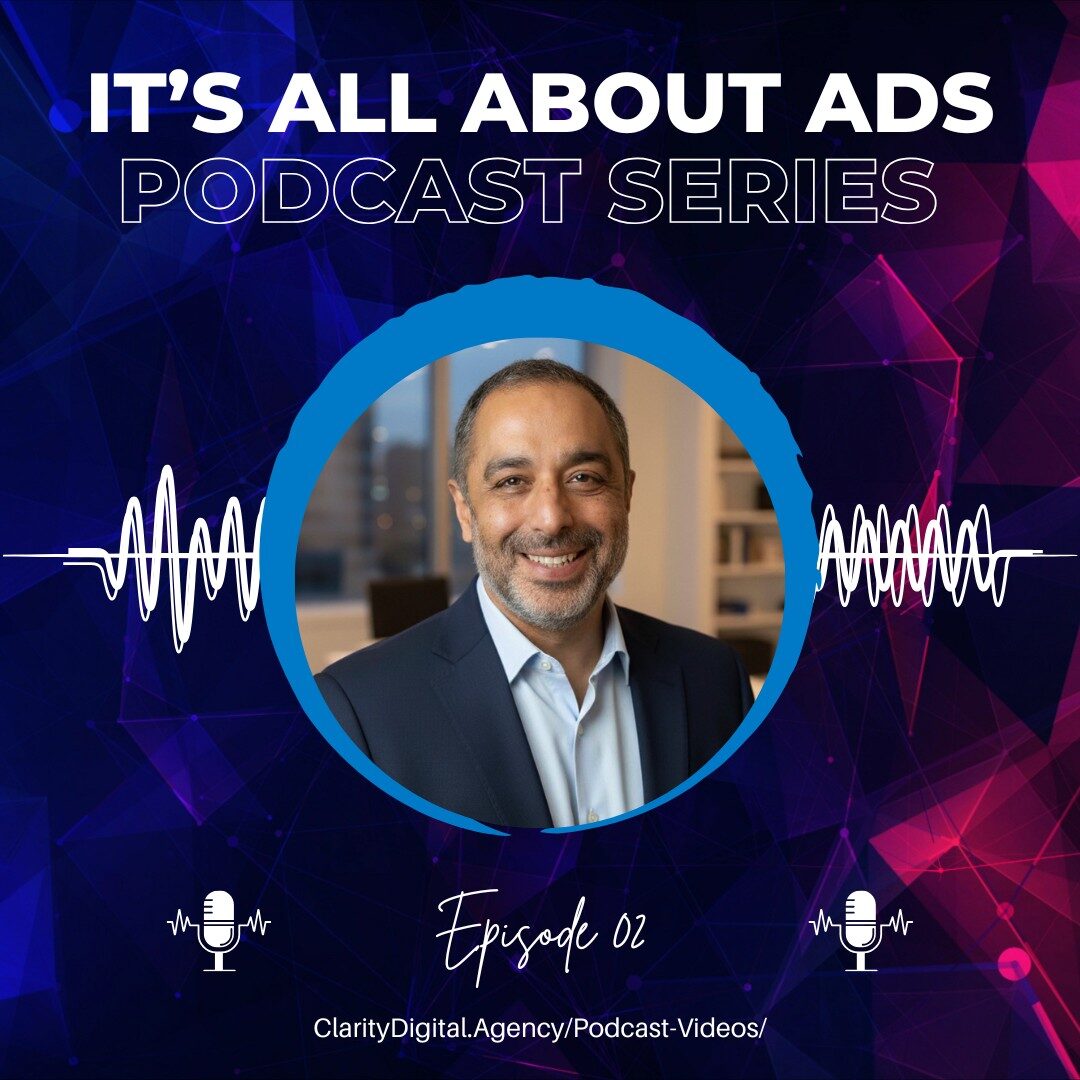In the ever-evolving world of marketing, the traditional CMO role is undergoing a transformation. On this episode of the Clarity Digital Pod, I sat down with Diane Haines, a seasoned marketing and product executive who has successfully made the shift from full-time leadership to thriving as a fractional CMO and CPO. With more than 25 years of experience in high-tech, marketing, and product management, Diane shares insights that are both timely and actionable for today’s marketing leaders and business founders.
Whether you’re a startup in need of executive marketing leadership but not ready to hire full-time, or you’re a full-time CMO considering a shift into fractional work, Diane lays out a framework for navigating this new terrain and she brings the receipts.
What is a Fractional CMO and Why Should Businesses Care?
The idea of a fractional executive isn’t new, but in recent years, it’s become more relevant than ever. Diane explains how fractional CMOs are not just for early-stage startups. While younger companies may rely on fractional leadership to access strategic expertise they can’t yet afford full-time, larger organizations are increasingly tapping into this model as well.
“I’ve been surprised by the range of companies reaching out,” Diane shares. “Some are startups who’ve never had a CMO before. Others are larger companies with an existing marketing team, but their head of marketing is overwhelmed or lacks certain strategic capabilities.”
In many cases, having an external, objective leader helps the internal team scale up faster or tackle specialized projects like integrating AI into existing workflows.
Why Diane Made the Shift to Fractional CMO
Diane’s transition into fractional work came after a successful exit. She had helped scale an HR tech company that was eventually acquired. After staying on through the post-acquisition transition to lead AI strategy, she was ready for something new.
“I’ve always had other passions I wanted to pursue. like teaching at the graduate level, but a full-time role just didn’t leave room for that,” she says.
What followed was a thoughtful, deliberate move into fractional work. Diane took time to plan with her executive coach, asking tough but important questions:
- How much do I want to work?
- What kind of clients do I want to support?
- What type of work gives me energy?
That clarity up front helped her avoid the trap many new independents fall into—saying yes to everything, only to regret it later.
Strategic Advice for Future Fractional CMOs
For anyone thinking about stepping into the fractional world, Diane’s advice is clear: plan deliberately and experiment wisely.
She tested different engagement models—retainers, hourly work, and project-based contracts—to learn what fit her best. “One client might pay hourly, another on retainer. Over time, you figure out what you like and what you absolutely don’t want to repeat,” she notes.
Diane also highlighted the importance of knowing your bandwidth and boundaries. Before taking any discovery calls, she was already clear on the type of work she would say no to—even if the paycheck was tempting.
Another key point she makes: your network will carry you—at first. Most new fractional professionals find their first few clients through their existing connections. But that dries up eventually. Diane suggests maintaining a strong presence in the marketing community, joining curated CMO groups, and building a personal brand early on.
The Hidden Value of Teaching & Academic Communities
One of Diane’s lesser-known business development strategies is actually teaching.
She began guest lecturing at a local graduate business school years ago and now teaches full courses and advises capstone projects. What she didn’t expect was how often this led to real-world opportunities.
“Most of these students are working professionals. Their companies need marketing help. Or the businesses sponsoring capstone projects need strategic guidance,” Diane explains.
But it’s not just the students. Fellow faculty—many of whom are business professionals themselves—have also become great connections. “It’s an unexpected networking channel that’s more about relationship-building than pitching,” she adds.
For fractional leaders looking to grow their exposure organically, academia could be a high-leverage, low-noise channel.
Should You Use Fractional Marketplaces and CMO Platforms?
Yes and no. Diane recommends trying a few to see what fits. Some platforms are heavily vendor-driven, where CMOs are constantly being pitched to. Others are highly curated and offer real opportunities from vetted companies looking for executive marketing leadership.
The key is to avoid being passive. The best outcomes often come from giving first—like offering helpful advice in a Slack channel, showing up for a panel discussion, or mentoring someone. Diane’s gotten real business simply by helping someone out, then having them come back asking for a deeper engagement.
“It’s relationship-led, not transactional,” she emphasizes.
The Role of Thought Leadership and Events
Speaking engagements and thought leadership articles are often recommended strategies for independent professionals, but Diane has a nuanced take.
“Don’t just speak because you think you should. Speak because you have a clear point of view,” she says.
With in-person events back in full swing, Diane is intentional about which conferences or meetups she attends. “Some events are all about community and learning. Others are targeted toward decision-makers,” she notes.
As someone who often speaks about AI in marketing, she’s learned to be strategic with her time. “I could go to an AI event every day in Portland if I wanted to. But I pick the ones where the people I want to work with are attending.”
Let’s Talk AI : Real Use Cases for CMOs & Marketing Leaders
When it comes to AI in marketing, Diane is what she calls an “AI optimist.” But she’s not blind to the hype either.
“I see AI as a powerful assistant, not a replacement,” she says.
Her examples go beyond basic content generation. Diane shared how one executive created a digital twin of herself using a language model. This twin helped her direct reports prepare for tough conversations or presentations by simulating how she’d likely respond. Eventually, her team created their own AI twins to improve internal communication.
Another example Diane mentioned was feeding a company’s CEO content into a large language model to mimic his tone of voice. “It helped the marketing team get closer to the brand voice without needing multiple rounds of edits,” she said.
She also uses LLMs to check if content aligns with brand guidelines, summarize research, or draft faster without skipping strategy.
That said, Diane warns against full automation. “Please don’t write blog content with AI and slap it on your site. It needs human editing and perspective,” she urges.
AI’s Impact on Marketing Jobs: Displacement or Evolution?
We also touched on the hard truths: AI is replacing some jobs. But Diane draws a helpful parallel with the automotive industry, where robots replaced some workers—but created higher-paying roles for those who maintained or trained those robots.
“The same is happening in marketing. If you were a copywriter, now you’re a content strategist. If you were a UI designer, now you’re a product design lead who spends more time on strategy,” she says.
AI should help marketers become more productive, creative, and strategic—not disappear altogether.
I agree with Diane. In our agency, for instance, we’ve shifted UI/UX designers away from pushing pixels in Figma and toward ideating innovative experiences. Tools like Claude or ChatGPT help us mock up landing pages in minutes, which our engineers then optimize and secure.
The key, Diane says, is to start with a problem—not the tool. If you’re chasing AI just to say you’re using it, you’re likely misapplying the tech. Start with a business challenge, then see how AI can support or accelerate the solution.
Life Outside the Office: Fractional Freedom
Diane is based in Portland, Oregon, but works with clients across the globe. Her flexible schedule has enabled her to travel extensively, including a recent month-long stint working remotely from Portugal.
She also spends time with her daughters, gardens, and teaches—all things that wouldn’t be possible in a traditional 9-to-5.
The fractional life has its trade-offs, but for someone like Diane—who thrives on challenge, variety, and continuous learning—it’s been a career-defining shift.
Wrap Up
Diane Haines exemplifies what modern marketing leadership looks like. She’s agile, strategic, tech-savvy, and deeply human. Her story isn’t just inspiring—it’s a playbook for any CMO, product leader, or executive who’s thinking about redefining what success looks like in this new marketing era.
Whether you’re considering the fractional path, looking to work with one, or just want to better integrate AI into your marketing, there are countless takeaways in this episode.




